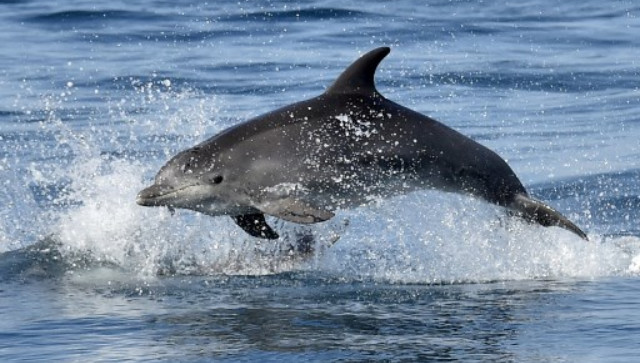The Faroe Islands said Sunday it would limit the hunting of dolphins during its controversial whale hunt to 500, following public outcry over the practice.
“An annual catch limit of 500 white-sided dolphins has now been proposed by the Ministry of Fisheries on a provisional basis for 2022 and 2023,” the government of the Danish autonomous territory made up of 18 islands said.
The quota was set after the “unusually large catch” of 1,423 white-sided dolphins in September last year, it said in a statement.
“Aspects of that catch were not satisfactory, in particular the unusually large number of dolphins killed,” it added.
“This made procedures difficult to manage and is unlikely to be a sustainable level of catch on a long-term annual basis.”
A review of the practice was launched in February, after a petition with almost 1.3 million signatures calling for a ban on the traditional hunt was submitted to the Faroese government.
What happens during the hunt?
In the Faroese tradition known as “grindadrap”, or “grind” for short, hunters surround dolphins or pilot whales with a wide semi-circle of fishing boats and drive them into a shallow bay where they are beached.
Fishermen on shore then slaughter them with knives.
Why the controversy?
Every summer, images of the bloody hunt make headlines around the world and spark outrage among animal rights activists and conservation activists who consider the practice barbaric and have been calling for it to end.
As per USA Today, local media reports that in the past there have been too many dolphins and too few people on the beach to slaughter them.
Why do the Islands allow this?
It’s tradition.
As per Yahoo News, the annual hunt, which takes place on the remote North Atlantic islands halfway between Iceland and Scotland, dates back to at least 1584.
Although whales are primarily hunted, the long-finned pilot whale, bottlenose dolphins, and Atlantic white-sided dolphins are also killed for their meat and blubber, as per the report.
Whales are killed by gashes to the neck and subsequent cuts to the spinal cord and carotid artery, as per CNN.
As per USA Today, around 1,000 sea mammals, mostly pilot whales, are killed annually.
Are there any other benefits?
Meat from the hunt is distributed among the participants and local communities, according to the Whales and Whaling in the Faroe Islands website. As per CNN, whale meat and blubber can also be found for sale on the dockside and at supermarkets.
However, dolphin meat consumption is thought to be declining over concerns regarding high level of mercury.
The Faroese Government has introduced strict health guidelines on its consumption as a result, as per Yahoo News.
The animals have fed local population for centuries.
As per Yahoo News, a poll by broadcaster Kringvarp Føroya found that while 83% of locals support killing pilot whales, 53% of islanders are opposed to killing the white-sided dolphin.
In 2020 only 35 white-sided dolphins were killed. Neither are on the endangered species list, as per the USA Today.
What has the government said?
The government stressed that the catches serve as an “important supplement to the livelihoods of Faroe Islanders”.
“The utilisation of both pilot whales and white-sided dolphins in the Faroe Islands is sustainable,” it added.
“The Government of the Faroe Islands continues to base its policies and management measures on the right and responsibility of the Faroese people to utilise the resources of the sea sustainably. This also includes marine mammals, such as pilot whales and dolphins,” the ministry said in its statement.
Given current stocks, the government said an annual quota of around 825 dolphins would be “well within sustainable limits”, but has recommended 500 as a provisional limit.
It added that it was waiting for an opinion from the Scientific Committee of the North Atlantic Marine Mammal Commission, expected in by 2024, after which it would review the provisional quota.
As per Al Jazeera, the ministry also said it would evaluate the procedures used to drive and kill the dolphins so that it would “be carried out as quickly and efficiently as possible”.
Only the dolphin hunt is currently being reviewed, not the entire “grind” tradition, the ministry added.
With inputs from agencies
Read all the Latest News , Trending News , Cricket News , Bollywood News , India News and Entertainment News here. Follow us on Facebook , Twitter and Instagram .


)




)
)
)
)
)
)